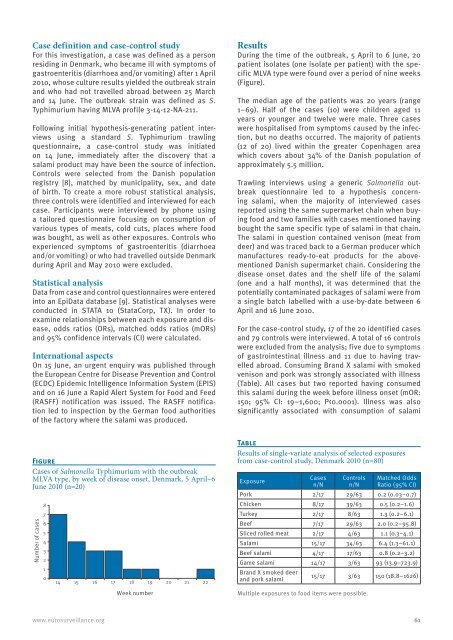Escherichia coli - Eurosurveillance
Escherichia coli - Eurosurveillance
Escherichia coli - Eurosurveillance
You also want an ePaper? Increase the reach of your titles
YUMPU automatically turns print PDFs into web optimized ePapers that Google loves.
Case definition and case-control study<br />
For this investigation, a case was defined as a person<br />
residing in Denmark, who became ill with symptoms of<br />
gastroenteritis (diarrhoea and/or vomiting) after 1 April<br />
2010, whose culture results yielded the outbreak strain<br />
and who had not travelled abroad between 25 March<br />
and 14 June. The outbreak strain was defined as S.<br />
Typhimurium having MLVA profile 3-14-12-NA-211.<br />
Following initial hypothesis-generating patient interviews<br />
using a standard S. Typhimurium trawling<br />
questionnaire, a case-control study was initiated<br />
on 14 June, immediately after the discovery that a<br />
salami product may have been the source of infection.<br />
Controls were selected from the Danish population<br />
registry [8], matched by municipality, sex, and date<br />
of birth. To create a more robust statistical analysis,<br />
three controls were identified and interviewed for each<br />
case. Participants were interviewed by phone using<br />
a tailored questionnaire focusing on consumption of<br />
various types of meats, cold cuts, places where food<br />
was bought, as well as other exposures. Controls who<br />
experienced symptoms of gastroenteritis (diarrhoea<br />
and/or vomiting) or who had travelled outside Denmark<br />
during April and May 2010 were excluded.<br />
Statistical analysis<br />
Data from case and control questionnaires were entered<br />
into an EpiData database [9]. Statistical analyses were<br />
conducted in STATA 10 (StataCorp, TX). In order to<br />
examine relationships between each exposure and disease,<br />
odds ratios (ORs), matched odds ratios (mORs)<br />
and 95% confidence intervals (CI) were calculated.<br />
International aspects<br />
On 15 June, an urgent enquiry was published through<br />
the European Centre for Disease Prevention and Control<br />
(ECDC) Epidemic Intelligence Information System (EPIS)<br />
and on 16 June a Rapid Alert System for Food and Feed<br />
(RASFF) notification was issued. The RASFF notification<br />
led to inspection by the German food authorities<br />
of the factory where the salami was produced.<br />
Figure<br />
Cases of Salmonella Typhimurium with the outbreak<br />
MLVA type, by week of disease onset, Denmark, 5 April–6<br />
June 2010 (n=20)<br />
Number of cases<br />
8<br />
7<br />
6<br />
5<br />
4<br />
3<br />
2<br />
1<br />
0<br />
14 15 16 17 18 19 20 21 22<br />
www.eurosurveillance.org<br />
Week number<br />
Results<br />
During the time of the outbreak, 5 April to 6 June, 20<br />
patient isolates (one isolate per patient) with the specific<br />
MLVA type were found over a period of nine weeks<br />
(Figure).<br />
The median age of the patients was 20 years (range<br />
1–69). Half of the cases (10) were children aged 11<br />
years or younger and twelve were male. Three cases<br />
were hospitalised from symptoms caused by the infection,<br />
but no deaths occurred. The majority of patients<br />
(12 of 20) lived within the greater Copenhagen area<br />
which covers about 34% of the Danish population of<br />
approximately 5.5 million.<br />
Trawling interviews using a generic Salmonella outbreak<br />
questionnaire led to a hypothesis concerning<br />
salami, when the majority of interviewed cases<br />
reported using the same supermarket chain when buying<br />
food and two families with cases mentioned having<br />
bought the same specific type of salami in that chain.<br />
The salami in question contained venison (meat from<br />
deer) and was traced back to a German producer which<br />
manufactures ready-to-eat products for the abovementioned<br />
Danish supermarket chain. Considering the<br />
disease onset dates and the shelf life of the salami<br />
(one and a half months), it was determined that the<br />
potentially contaminated packages of salami were from<br />
a single batch labelled with a use-by-date between 6<br />
April and 16 June 2010.<br />
For the case-control study, 17 of the 20 identified cases<br />
and 79 controls were interviewed. A total of 16 controls<br />
were excluded from the analysis; five due to symptoms<br />
of gastrointestinal illness and 11 due to having travelled<br />
abroad. Consuming Brand X salami with smoked<br />
venison and pork was strongly associated with illness<br />
(Table). All cases but two reported having consumed<br />
this salami during the week before illness onset (mOR:<br />
150; 95% CI: 19–1,600; P

















